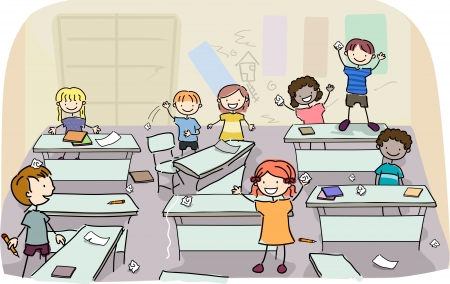How many times have you heard, “I could do a better job teaching if these kids would just behave and mind the rules”? Student behavior in the classroom is a priority for teachers. Too often disruptions cause a loss of teaching and learning time.
Many examples of students’ inappropriate behavior stem around the need to gain attention, power plays, and/or a lack of self-esteem. These types of negative classroom behaviors can be identified, addressed and strategies implemented to correct them. I encourage teachers to do their best to notice students who come to class with any of the following: chips on their shoulders, show-off attitudes, their heads down, disgruntled looks, or those whose are constantly trying to do anything to get out of classwork. Each child must be considered an individual within a group.

I remember a time I was teaching fourth grade and daily greeted my students at the door. One child, Jessie, came to school almost every day with a smirk on her face. I would say, “Good Morning, Jessie”, to which she replied, “No” in a tone of utter contempt. Then proceed to bump against and almost push her way through the door. I did not react, as she was not hurting anyone. Throughout the day, she continued to mumble under her breath and grunt out loud regardless of the lesson or activity. During recess, Jessie would sit on a bench by herself. She rarely completed assignments. I tried the “methods” from multiple behavior books to no avail. After about three weeks of this, I began to look into her home life. Her parents had recently divorced, and she spent time during the week with one parent and on the weekends with another.

I first sought out the school counselor. She agreed to come and observe the behavior. The counselor noted that the worst episodes occurred in the morning and right before dismissal. We then called for a parent conference with both parents. The counselor was there in case we needed mediation. When we brought up the issues with her behavior, more information came to light. Apparently, not only did the parents share custody, but one brought her to school while another one picked her up. Jessie’s behavior was a cause of her insecurity, as she never knew which parent was taking or picking her up from school. The parents agreed to set up a schedule to follow. This alleviated the issue with her behavior but did not improve her socialization with classmates. I decided to intervene by assigning all students partners in class. In this manner, Jessie was not singled out. The class assisted me in setting up “partner rules” for class assignments, lunchtime, and recess. We rotated partners every two weeks. I had an odd number of students, so some groups were of 2 and others 3. It was amazing how the students all became better behaved and looked forward to being a “star” partner with their classmate.
Another issue can be that of defiance and bullying. Many programs exist to help students and schools to identify and decrease these behaviors. The defiant bully in a class wants power over other students and the teacher. I urge you to contact your school administrator for assistance with this type of student. The “partner rules” may help, but a close parent/teacher/administrator relationship must be set up immediately. Students need to learn to not be intimidated by a bully, to ask the bully to stop, to walk away and most importantly to report immediately. Also, if a student sees bullying, they need to support the victim and stand-up for their classmates. Let students know that if they do not report bullying of others, they are in fact participating in the bullying actions. Be sure that your school has a policy in place that is taught to the students, teachers, and parents regarding how to eliminate and report bullying. The most effective way to implement such a program is to model for the students, have staff keep an eye out and report any students who might exhibit bullying tendencies, hold mandatory parent meetings whereby all parents hear the program details and become involved. If parents are unable to attend these meetings, design letters, parents, flyers, and emails to send home (in the student’s home language).
A low self-esteem can also lead to class disruptions. One way to improve self-esteem in students is to develop a goal plan for each grading period for each student. I developed a form for my students. To model this, I made my own goal plan for myself and shared it with them. The form included: what do I want to learn this grading period, something I am good at, and what I think we could learn new in class. Each student then fills out the form. The form is kept secret from all the other classmates and only shared one on one with the teacher. This gives the teacher input on each child and how they feel about themselves and their learning.
The form can be kept inside the student’s notebook to be read each day before lessons begin. It can be changed by the student with teacher approval of the changes. At the end of the grading period, the teacher meets again with each student to review the goal set. On mine I wrote that I wanted to learn how to make my desk cleaner during the day, that I can teach my students in a positive way and that I thought we should learn about cats, since I am a cat lover. I used the “what I want to learn” suggestions to help set up center activities for the class. That year, I had a student in fourth grade that had failed numerous times, and had a major back deformity, but did not qualify for special education. She read on a first-grade reading level and had difficulty in learning how to multiply. She was constantly bothering others in class for help. I tried to work one on one with her when possible. Sadness surrounded her most of the day. When she was ready to share her goal with me, she was almost crying. She wrote that she wanted to learn how to multiply and write better. Her best attribute was that she shared her school supplies with others and she helped her little brother at home. Her goals did not change much the first two grading periods, except that she did learn to write better. We did a drill every day with multiplication facts when the students entered the room. Her tutor and I worked diligently on them with her. By the third grading period, she wrote on her form, “I can multiply.” She was so excited. Even though we had progressed far beyond multiplication, I continued the multiplication drills daily. She was my star multiplier. Did she read better? No, but I paired her with good readers who would read aloud our class novels to her.
Teachers can deal with misbehavior in positive ways. As an administrator, I asked teachers each year to determine one classroom behavior that they could not stand. To focus on that with their class. Tell students what behavior disrupts class the most. Reward the class when they do not exhibit that behavior for that grading period. Then add another the next grading period. If a teacher is irritated by multiple behaviors, they will not gain class control by focusing on all of them. Student behavior can only be changed if the student is willing to change that behavior. Research shows that it takes about 45 days to change a given behavior. That takes tolerance on the part of the teacher and class. Poor classroom behavior cannot be taken personally by the teacher. It needs to be addressed privately when it is confrontational and parent support must be gained.
The teacher must be the professional and find ways to encourage each student individually to become successful in class both academically and socially. Modeling and being encouraging positive behavior is essential.
More information on this and other strategies can be gained from education websites such as www.masterteacher.com, and www.middleweb.com/6027/3-steps-to-improved-behavior/ .
